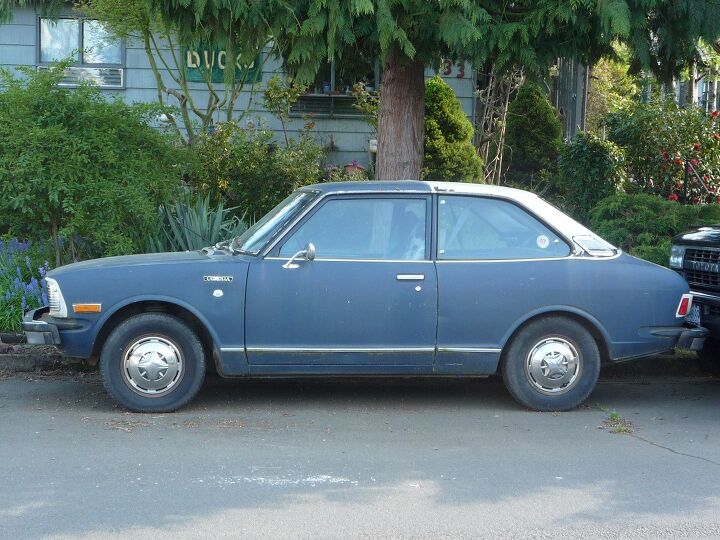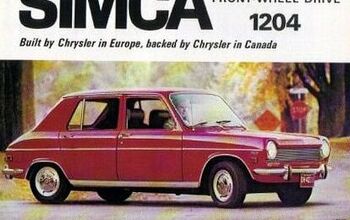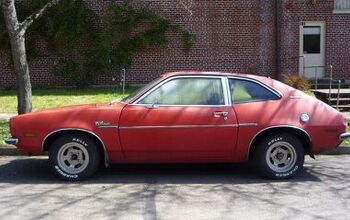Curbside Classics: 1971 Small Cars Comparison: Number 3 - Toyota Corolla

Curbside Classics takes you back to 1971 for a virtual comparison test of six small cars, based (and partly borrowed) from a C/D test.
Hail the conquering hero! Well, not of C/D‘s comparison test, but who cares, as long as the sales are there. And by 1971, the Corolla was well along in its conquest of the US small car market, despite being only three years fresh. In 1969, only its second year on the US market, the Corolla leapt to the number two import sales spot, and was nipping hard at the Beetle’s pointy tail. Try replicating that today! And by 1975, the “little crown” was lording over the defeated krabbeltier. So what exactly were the Corolla’s remarkable qualities that sent VW (and Opel) into such a deep and permanent retreat? And its shortcomings that kept it from winning this comparison?
Let’s start by looking at what it was up against. The Beetle’s well known qualities have already been covered in this comparison. In 1971, it was still hanging on stubbornly. But the number two import Opel Kadett was thoroughly pushed aside by the Japanese upstart. Or more accurately, fell aside. By 1971, the rising German currency and GM’s planned import killer Vega caused Opel to drop the aged Kadett and focus on the more upscale market with its 1900 Sports Sedan (Ascona) and Manta.
And the rest of the import competition in 1971? There were some seriously advanced Europeans knocking on the door. Think Fiat 128, Austin America (1100), Peugeot 304, Simca 1100/1204, Renault R16. Highly sophisticated FWD cars, but each with questionable durability and iffy dealer networks. At the hands of America’s abusive and maintenance-neglecting drivers, this was not exactly a recipe for success. The best hopes were with the other new Japanese small cars, such as the Datsun 1200. Japan’s sun(ny) was rising quickly over the US in 1971.
The ’71 Corolla encapsulated all the qualities that have made it a perennial top seller. Well, except one. Remember all our talk in prior episodes about Americans’ desire to roll stress-free down the freeway at seventy? The 1200 cc engine in this model just didn’t cut it for that: “with its 4.22 axle ratio and 12-inch wheels, the engine fairly screams at 70 mph…at low speeds and in traffic the car is fun to drive, however, and it feels the most like a sports car than the others.” I guess the Corolla has changed in some regards; the word “sports car” sure didn’t come to mind when I reviewed the current Corolla. Now it’s the consummate freeway isolation box.
But Toyota is (usually) a quick study. Within a year or so, it offered the legendarily-durable 1600 cc hemi-head 2T-C engine. Especially when combined with the slick new 5-speed stick, it alleviated any lingering freeway-compatibility questions for the Corolla. If C/D‘s tester had been a 1600, it might well have won outright.
Corollas have generally been appreciated for their interior qualities, although that is in regression now too. Back in ’71, it offered a remarkably pleasant place to be, considering how small and light (1785 lb!) it was. C/D praised the remarkably roomy back seat (surprising for a tiny RWD car): “usually in critical supply in cars of this size” and the interior generally: “carpeting is standard, high quality vinyl is used to cover the seats and door panels and the whole package is coordinated in pleasing colors…the instrument panel is attractive and highly functional.”
A good friend bought the exact same car as this tester, for which she traded in a ’69 big-block Fury. Well, that sure ended the high-speed dashes across the heartland. As the energy crisis set in we piled into the Corolla for shorter-distance summer fun: skinny-dipping at the quarries that dot eastern Iowa. If you look carefully, you can still see the seam lines of a hot black vinyl Corolla seatback etched into my backside.
The sensations of barreling the Corolla 1200 down gravel country roads are equally etched in my memory. It was a (relatively) fun drive, in the classic light, small underpowered RWD way that has long gone the way of other automotive dinosaurs (not all the dinos were big). Very quick and light unassisted steering, maybe a hair imprecise. Remarkably light and crisp shifting tranny. Hair-trigger clutch. Brakes were so-so, even for the times. It may have felt “sporty,” but the 1200 could never reach sporty speeds straight ahead or in (paved) corners, where the Corolla perpetually wanted to assume the dog-at-hydrant pose.
Taking gravel corners quickly was another story. That generally has more to do with the driver than the car. But the Corolla was a balanced and confidence-inspiring drifter, and gravel was the only way to drift the underpowered cars back then; Iowa’s Not-So-Fast and Furious.
No doubt about the Corolla 1200 being pokey. It’s pretty obvious that Car and Driver‘s test Corolla wasn’t a “ringer.” Theirs clocked a pathetic 15.5 seconds 0-60, and even worse, tied the Beetle with a 19.8 second quarter mile. But it would get about 30 mpg, no matter how hard you flogged it (perpetually, out of necessity).
Elinor’s 1200 Corolla was totaled when she lent it to a friend. Doesn’t it always happen like that? But the replacement had the 1600, and the difference was very palpable: 100 horsepower for 1800 lb. That’s a better power-to-weight ratio than a new Corolla. Now, high-speed dashes across the desert in the Corolla were once again the order of the day.
So to answer the question we posed at the beginning, the Corolla was essentially what it is today: an efficient, economical, relatively comfortable appliance. But what really burnished the Corolla reputation over the years was its legendary reliability and durability. 1971 was a bit early to fully see that one coming, although Toyota ads of the time already crowed about their attention to materials and details. And the Corolla was already running reliability rings around the broken-down European competition (VW excepted).
So I assumed that I wouldn’t have any trouble finding a suitable Corolla to pose for me. Seems like just yesterday that these were everywhere. And serious rust is not an issue here. I started to get antsy after a few weeks of keeping my eyes peeled. Finally, on a bike ride, I gave a whoop when I saw this one a block down the street. You’d think I’d just found a Dino sitting at the curb.
This ’74 (with the add-on cow-catcher bumpers) has been owned by its loving owner since 1976. And her Land Cruiser creates a nice commentary on Toyota’s “growth.” Yes, folks do tend to come out and see what’s going on when someone is taking pictures of their beloved old car. But wariness quickly turns to appreciation, when they find out their car is going to have its fifteen minutes of fame. Or, in the Corolla’s case, forty years, which we celebrated here. The world’s best selling car for decades; who would have guessed that in 1971? Can Toyota keep it that way?

More by Paul Niedermeyer
Latest Car Reviews
Read moreLatest Product Reviews
Read moreRecent Comments
- CanadaCraig My 2006 300C SRT8 weighs 4,100 lbs. The all-new 2024 Dodge Charge EV weighs 5,800 lbs. Would it not be fair to assume that in an accident the vehicles these new Chargers hit will suffer more damage? And perhaps kill more people?
- Akila Hello Everyone, I found your blog very informative. If you want to know more about [url=
- Michael Gallagher I agree to a certain extent but I go back to the car SUV transition. People began to buy SUVs because they were supposedly safer because of their larger size when pitted against a regular car. As more SUVs crowded the road that safety advantage began to dwindle as it became more likely to hit an equally sized SUV. Now there is no safety advantage at all.
- Probert The new EV9 is even bigger - a true monument of a personal transportation device. Not my thing, but credit where credit is due - impressive. The interior is bigger than my house and much nicer with 2 rows of lounge seats and 3rd for the plebes. 0-60 in 4.5 seconds, around 300miles of range, and an e-mpg of 80 (90 for the 2wd). What a world.
- Ajla "Like showroom" is a lame description but he seems negotiable on the price and at least from what the two pictures show I've dealt with worse. But, I'm not interested in something with the Devil's configuration.







































Comments
Join the conversation
My only new-bought car was a 1974 Corolla, bought at Hampshire Toyota in Northampton MA for $2367. The salesman was named Joel Leavitt. A new car was a big deal for a 19-yr-old kid in April 1974 and I remember every detail like it was yesterday. I also remember when the mighty 1200cc engine had a connecting rod come loose and stop the engine dead on I-84 in May 1977, two months after I made the last payment, but that's a whole new batch of swear words. I do remember buying a set of Semperit radials (155SR12) for this car in 1975 which improved the handling no end. Not having to slow down for curves to hold traction really made going from point A to point B a faster proposition. Excellent car for a college kid during the 1970s. Cheap to fill up, easy to work on but do I wish I'd sprung for the 1600cc engine! One other bit of fun was to pull up to a filling station and let the attendant spend five minutes looking for the gas cap. (It's under the dummy exhaust vent on the left-side C-pillar.)
This car might have changed the world, but it does absolutely nothing for me. Boring, bland, ugly, no style whatsoever. Much like modern Toyotas. I would rather have a stylish imperfect car than a bland car that runs perfectly. Give me a Yank tank over this tin can any day.